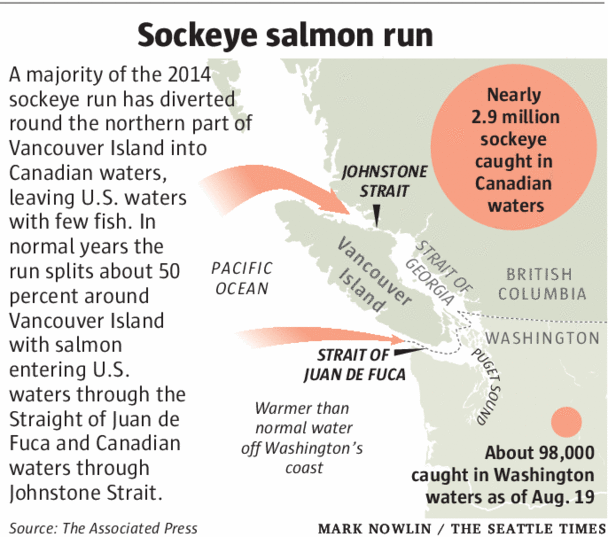Unusually warm water off the Washington coast is sending the vast majority of the sockeye-salmon run to Canadian waters, leaving Puget Sound fishermen with nearly empty nets.
By: Associated Press
BELLINGHAM — Unusually warm water off the Washington coast is sending the vast majority of the sockeye-salmon run to Canadian waters, leaving Puget Sound fishermen with nearly empty nets.
According to data from the Pacific Salmon Commission, nearly 2.9 million sockeye have been caught in Canadian waters, while only about 98,000 have been netted in Washington through Aug. 19.
That means 99 percent of sockeye have gone through the Johnstone Strait around the northern part of Vancouver Island into Canadian waters.
During a typical sockeye-salmon run, about 50 percent of the run goes around the south end of Vancouver Island through the Strait of Juan de Fuca, putting them in U.S. waters, The Bellingham Herald reported.
This year’s diversion rate is unusual. If it stays around this level, it would be the highest diversion rate on record, dating from 1953, said Mike Lapointe, chief biologist for the Pacific Salmon Commission.
The sockeye run is expected to continue for several more weeks, so U.S. fishermen like Pete Granger hope to salvage what they can. Granger is a reefnet fisherman who is operating his boat near Lummi Island. He has been catching fish for the Lummi Island Wild Co-op for the past eight years.
“It could be one of the worst seasons we’ve had in a long time,” Granger said. The fishing numbers in U.S. waters started to improve at the end of last week, with several weeks left in the season.
Several factors could be behind why sockeye decided to head for the Johnstone Strait this summer, but researchers are looking closely at an area of ocean water off the coast that is about 3 degrees Celsius warmer than normal. Nick Bond, a research scientist for the University of Washington, refers to this area as a “warm blob” that developed last winter as the Pacific Northwest went through a period of unusually quiet weather. Last winter, the area had stretches of cool, windless and foggy days.
The calm weather meant the ocean didn’t do its usual churning of deeper, colder water up to the surface. With this pattern continuing into summer, the warm area has persisted. Sockeye prefer cooler water, which may be why most of the run went north around Vancouver Island.
Bond believes the development of the warm blob is not a direct result of global warming but more of a fluke. Looking back at past data, there has been the occasional season when a cold area has developed off the coast, sending the sockeye south of Vancouver Island into U.S. waters.
This season’s event is giving scientists a chance to learn what impact a warmer ocean would have on this area’s ecosystem, giving them more information to make better predictions.
Given the current weather models, Bond said, the warm blob could be around for a while, possibly well into 2015. There’s also the potential of El Niño developing later this year, bringing warm water to the area. If that’s the case, it could be disruptive for next year’s pink-salmon run as well.

